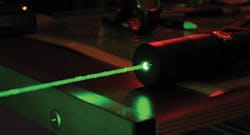Lockheed Martin, Boeing, General Atomics eye laser weapons to counter ballistic missiles
ALBUQUERQUE, N.M. - Unmanned aircraft weapons experts at Boeing are joining a program to develop laser weapons that could lead to a weapon for future unmanned aerial vehicles (UAVs) able to destroy enemy ballistic missiles in boost phase.
Laser weapons of the future may help destroy or disable enemy ballistic missiles in boost phase from unmanned aircraft.
Officials of the U.S. Missile Defense Agency (MDA) in Albu-querque, N.M., announced a $10 million contract to Boeing Defense, Space & Security in Huntington Beach, Calif., for the Low Power Laser Demonstrator (LPLD) phase one effort. Boeing joins the General Atomics Electromagnetic Systems group in San Diego and the Lockheed Martin Corp. Space Systems segment in Sunnyvale, Calif., for LPLD phase one.
The LPLD project seeks to develop enabling technologies for a future high-energy laser weapon aboard a high-altitude UAV designed to attack and destroy enemy ballistic missiles in boost phase. Lockheed Martin, General Atomics, and Boeing are addressing laser power and aperture size by integrating and testing a low-power laser on a UAV.
MDA announced an $8.9 million contract to General Atomics in November, and a $9.4 million contract to Lockheed Martin in October for LPLD phase one.
Boeing's expertise in high-energy weapons include the company's truck-mounted High Energy Laser Mobile Demonstrator (HEL MD) for use against air and ground targets, and the YAL-1 Airborne Laser Testbed, which was a megawatt-class chemical oxygen iodine laser (COIL) mounted inside a modified Boeing 747-400F jetliner.
Lockheed Martin is involved in the U.S. Air Force Laser Advancements for Next-generation Compact Environments (LANCE) project to develop a compact, ruggedized, high-power laser to defend tactical aircraft flying at or above the speed of sound from enemy aircraft and missiles. LANCE is part of the Air Force's Self-protect High Energy Laser Demonstrator (SHiELD) demonstration to develop and assess a high-energy laser (HEL) for use against enemy aircraft, missiles, and other airborne threats.
General Atomics has expertise in advanced electromagnetic and electric power generation technologies to harness electric power efficiently. The company specializes in high-voltage capacitors for direct current, pulsed power, high-frequency alternating current, and pulsed power systems powerful enough to support future railgun applications and all-electric aircraft carrier catapults. General Atomics also specializes in power-management and energy-storage technologies. Another segment of the company, General Atomics Aeronautical Systems in Poway, Calif., designs UAVs such as the Predator, Reaper, Gray Eagle, and Avenger.
The ability to destroy enemy ballistic missiles in boost phase is particularly beneficial because with one shot it could destroy multiple independently targeted missile warheads, as well as decoys designed to foil missile defenses.
Boeing, General Atomics, and Lockheed Martin are the three LPLD contractors chosen this year who, if successful in the program's first phase, will move on to a technology demonstration in the LPLD program's second phase.
In the yearlong first phase, the three companies will perform system design, and in the second phase will build, integrate, and test a functional low-power laser for beam control and stability. Officials anticipate a low-power flight test by 2020 and beam stability testing by 2021.
Boeing will do its work in Hun-tington Beach, Calif., and Albuquer-que, N.M. General Atomics will do its work in San Diego and Poway, Calif. Lockheed Martin will do its work in Sunnyvale and Palo Alto, Calif.; Louisville, Colo.; and Albuquerque, N.M. All three companies should be finished by summer 2018.
For more information visit the MDAonline at www.mda.mil.

